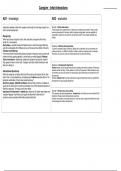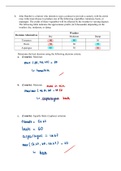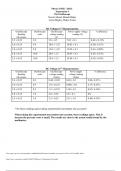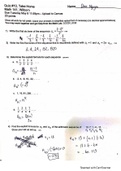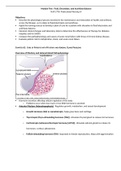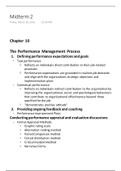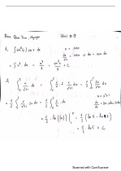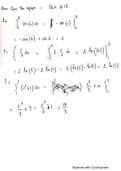Caregiver - Infant Interactions
AO1 - knowledge AO3 - evaluation
Interactions between infant and caregiver are thought to have large impacts on a Strength - Filmed observations
child’s social development. These studies were usually filmed in a laboratory, providing many benefits. These include:
removing distractions for the baby, ability to analyse footage later, inter-rater reliability of
observations, babies do not know they are being recorded. This increases reliability and
Reciprocity validity.
When each person responds to the other and elicits a response from them,
similar to a conversation.
Alert phases - periodic phases that babies have in which they signal that they Weakness - Difficulty observing babies
want to be interacted with. Mothers pick up on this around two-thirds of the time It is hard to interpret a baby’s behaviour. Babies lack coordination and so movements are
(Feldman and Eidelman) subtle and minute. It is difficult to identify if a baby is smiling or passing wind, for example.
From around three months alert phases increase in frequency and involves both Therefore, we cannot be sure that certain behaviours have special meaning.
mother and baby paying attention to verbal and non-verbal signals (Feldman).
Active involvement - traditionally, babies are thought to be passive, however
they appear to take an active role. Caregiver and baby initiate interactions and
take turns doing so. Weakness - Developmental Importance
Feldman points out that interactional synchrony simply gives names to patterns of behaviour
Interactional Synchrony between mother and baby. These studies do not tell us the purpose of these behaviours and
so therefore we cannot be certain from observations alone that these are important for child
When the caregiver and baby reflect both the actions and emotions of the other development.
and do this in a coordinated way, simultaneously. Feldman describes this as “the However, Isabella et al found that achievement of good interactional synchrony predicts the
temporal coordination of micro level social behaviour”. development of a good quality attachment.
Synchrony begins - Meltzoff and Moore observed this synchrony in babies as
young as two weeks old. An adult would display one of three facial expressions or
distinctive gestures. The baby would mirror these.
Importance for Attachment - Isabella et al. observed 30 mother and babies and Strength - Practical value versus ethics
This research has practical applications. Crotwell et al. found that a ten-minute Parent-Child
compared degree of synchrony and quality of attachment. High levels of Interaction Therapy improved interactional synchrony.
synchrony were associated with better quality attachment. However, this research is socially sensitive as it can be used to argue that mothers that work
risk damaging their baby’s development.
, Stages of Attachment
AO1 - knowledge AO3 - evaluation
Schaffer and Emerson studied the attachment behaviours of babies. They Strength - Good external validity
proposed four identifiable stages. Most observations were made by parents and reported to researchers. If researchers were to
observe, the babies may be distracted or anxious. Babies were therefore behaving naturally.
However, mothers would not have been fully objective. For example, they may have not
Stage 1: Asocial stage noticed or misremembered when their baby was anxious and failed to report this.
A baby’s behaviour towards people and inanimate objects are similar. However,
they do display signs of preferring to be with people as well as preferences for
certain people that can comfort them more easily.
Stage 2: Indiscriminate attachment Weakness - Poor evidence for the social stage
From 2 to 7 months, babies display more obvious social behaviours, preferring Young babies have poor coordination and are fairly immobile. If young babies were anxious,
to be with humans rather than objects. Whilst they still have preferences, babies they may have shown this in subtle ways, making it difficult for mothers to observe and report.
can be comforted by anyone. They do not show separation anxiety nor stranger Babies may actually be social but appear to be asocial.
anxiety.
Stage 3: Specific attachment
From around 7 months, babies begin to display signs of attachment to a specific
Strength - Real world application
person, showing separation and stranger anxiety. Practical application in a daycare. In the asocial and indiscriminate stages, introducing a baby
It is at this point the baby forms a bond with the primary attachment figure. This to daycare is straightforward, whereas in the specific attachment stage this is more
is not who they spend the most time with but who offers the most interaction and problematic. Parents can plan daycare through Schaffer and Emerson’s stages.
responds to the baby’s ‘signals’. This is the mother 65% of the time.
Stage 4: Multiple attachments
Shortly after this primary attachment, babies begin to extend this behaviour to
Weakness - Generalisability
multiple attachments with whom they regularly spend time. These are called
They looked at one sample which had unique features in terms of cultural and historical
secondary attachments. 29% formed secondary attachments within a month of context - 1960s working class Glasgow. In more collectivist cultures, multiple attachments
forming a primary attachment. Most had formed multiple attachment by 1 year from an early age are more the norm (van Ijzendoorn)
old.
AO1 - knowledge AO3 - evaluation
Interactions between infant and caregiver are thought to have large impacts on a Strength - Filmed observations
child’s social development. These studies were usually filmed in a laboratory, providing many benefits. These include:
removing distractions for the baby, ability to analyse footage later, inter-rater reliability of
observations, babies do not know they are being recorded. This increases reliability and
Reciprocity validity.
When each person responds to the other and elicits a response from them,
similar to a conversation.
Alert phases - periodic phases that babies have in which they signal that they Weakness - Difficulty observing babies
want to be interacted with. Mothers pick up on this around two-thirds of the time It is hard to interpret a baby’s behaviour. Babies lack coordination and so movements are
(Feldman and Eidelman) subtle and minute. It is difficult to identify if a baby is smiling or passing wind, for example.
From around three months alert phases increase in frequency and involves both Therefore, we cannot be sure that certain behaviours have special meaning.
mother and baby paying attention to verbal and non-verbal signals (Feldman).
Active involvement - traditionally, babies are thought to be passive, however
they appear to take an active role. Caregiver and baby initiate interactions and
take turns doing so. Weakness - Developmental Importance
Feldman points out that interactional synchrony simply gives names to patterns of behaviour
Interactional Synchrony between mother and baby. These studies do not tell us the purpose of these behaviours and
so therefore we cannot be certain from observations alone that these are important for child
When the caregiver and baby reflect both the actions and emotions of the other development.
and do this in a coordinated way, simultaneously. Feldman describes this as “the However, Isabella et al found that achievement of good interactional synchrony predicts the
temporal coordination of micro level social behaviour”. development of a good quality attachment.
Synchrony begins - Meltzoff and Moore observed this synchrony in babies as
young as two weeks old. An adult would display one of three facial expressions or
distinctive gestures. The baby would mirror these.
Importance for Attachment - Isabella et al. observed 30 mother and babies and Strength - Practical value versus ethics
This research has practical applications. Crotwell et al. found that a ten-minute Parent-Child
compared degree of synchrony and quality of attachment. High levels of Interaction Therapy improved interactional synchrony.
synchrony were associated with better quality attachment. However, this research is socially sensitive as it can be used to argue that mothers that work
risk damaging their baby’s development.
, Stages of Attachment
AO1 - knowledge AO3 - evaluation
Schaffer and Emerson studied the attachment behaviours of babies. They Strength - Good external validity
proposed four identifiable stages. Most observations were made by parents and reported to researchers. If researchers were to
observe, the babies may be distracted or anxious. Babies were therefore behaving naturally.
However, mothers would not have been fully objective. For example, they may have not
Stage 1: Asocial stage noticed or misremembered when their baby was anxious and failed to report this.
A baby’s behaviour towards people and inanimate objects are similar. However,
they do display signs of preferring to be with people as well as preferences for
certain people that can comfort them more easily.
Stage 2: Indiscriminate attachment Weakness - Poor evidence for the social stage
From 2 to 7 months, babies display more obvious social behaviours, preferring Young babies have poor coordination and are fairly immobile. If young babies were anxious,
to be with humans rather than objects. Whilst they still have preferences, babies they may have shown this in subtle ways, making it difficult for mothers to observe and report.
can be comforted by anyone. They do not show separation anxiety nor stranger Babies may actually be social but appear to be asocial.
anxiety.
Stage 3: Specific attachment
From around 7 months, babies begin to display signs of attachment to a specific
Strength - Real world application
person, showing separation and stranger anxiety. Practical application in a daycare. In the asocial and indiscriminate stages, introducing a baby
It is at this point the baby forms a bond with the primary attachment figure. This to daycare is straightforward, whereas in the specific attachment stage this is more
is not who they spend the most time with but who offers the most interaction and problematic. Parents can plan daycare through Schaffer and Emerson’s stages.
responds to the baby’s ‘signals’. This is the mother 65% of the time.
Stage 4: Multiple attachments
Shortly after this primary attachment, babies begin to extend this behaviour to
Weakness - Generalisability
multiple attachments with whom they regularly spend time. These are called
They looked at one sample which had unique features in terms of cultural and historical
secondary attachments. 29% formed secondary attachments within a month of context - 1960s working class Glasgow. In more collectivist cultures, multiple attachments
forming a primary attachment. Most had formed multiple attachment by 1 year from an early age are more the norm (van Ijzendoorn)
old.

